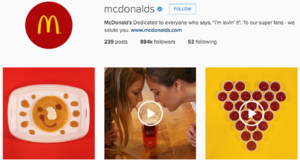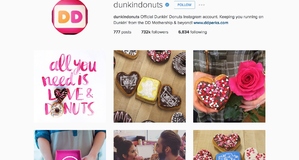From Elon Journal of Undergraduate Research in Communications VOL. 7 NO. 1A Content Analysis of Celebrity Instagram Posts and Parasocial Interaction
By
Elon Journal of Undergraduate Research in Communications 2016, Vol. 7 No. 1 | pg. 1/1
IN THIS ARTICLE
KEYWORDS
AbstractInstagram allows users to share a snapshot of their lives with a mass audience in a matter of seconds. This capability and power has not gone unnoticed by celebrities, who are highly aware of the impact their social media accounts have on fans and the relationships they create. The purpose of this study is to find fan engagement and the parasocial phenomenon in celebrities' Instagram activity. It analyzed 50 Instagram posts of three female singers—Taylor Swift, Selena Gomez, and Ariana Grande—to find which categories of posts engage fans. It also investigated the parasocial phenomenon in fans' comments. I. IntroductionAfrican-American Social networking sites (SNS) are applications that allow users to create a personal profile and then connect with people to share information, personal thoughts, and other types of media (Tsiotsou, 2015). These sites range from Facebook featuring a compilation of status updates, messaging, and photo-sharing, to the more recent platform Snapchat, which allows users to send photos to friends that disappear in a matter of seconds. For all platforms, the ideas of connectivity and network-building are key. In most instances, these connections are a result of two-sided relationships; family, friends, acquaintances, colleagues, etc. are all people with whom a real-life interaction has occurred. However, there are some instances where this is not the case; these are known as parasocial relationships. Parasocial relationships are born after continuous parasocial interaction, which often occurs with media figures and celebrities who have extensive fan bases. Fans have a desire for connection, but contact is almost exclusively one-sided. When it comes to SNS, celebrities have millions of followers. Since there are thousands of notifications and replies for each celebrity's post, it is impossible for the celebrity to see and respond to each individual. Research has shown that even with the lack of a personal response from the celebrity, an audience may still respond emotionally. When given a look into a celebrity's personal lives, fans believe themselves to be a part of the network (de Backer, Nelissen, Vyncke, Braeckman, & McAndrew, 2007). Instagram, an image-driven platform, creates a unique visually oriented storytelling opportunity. The de Backer et al. (2007) article emphasized the importance of Twitter as a new forum for parasocial interaction. Instagram takes this interaction a step further. For fans, it is more than just a status update from their favorite celebrity; it is an actual look into what that person is doing. This sets the stage for what may develop into parasocial attachment, having implications on an individual's psychological and lifespan development (Stever & Lawson, 2013). This capability and power has not gone unnoticed by the celebrities themselves; they are highly aware of the impact their social media accounts have on fans and the relationships they create. One of the best examples is pop superstar Taylor Swift. As of September 2015, Swift is the most followed person on Instagram ("Top 100 instagram, 2015). In addition to the typical self-promotion and personal interest content, she is known for replying to and commenting on fan pictures and posts and sending them the occasional present or two (Borison, 2014). Her fans, like many other celebrity worshipers, are exposed to personal information, and then taken further away from reality and deeper into the world of parasocial interaction. This study examined celebrities' Instagram activity to find out what posts engage fans and to what extent they are used to promote a community conducive to the development of parasocial interaction. II. Literature ReviewFor this study, a literature review was done on the concept of parasocial interaction, other related theories, studies on Instagram, and research on parasoical interaction focusing on television programming. Parasocial Interaction and other related theories"Parasocial interaction (PSI) refers to an imaginary social relationship, an imaginary friendship, an illusion of face-to-face relationship and an interpersonal interaction between the media user and the consumed media" (Tsiotsu, 2015, p. 403). The concept of PSI was first established in 1956 by Donald Horton and Richard Wohl. It wasn't until the 1970s, when uses and gratifications theory was applied to mass communication research, that interest in PSI took off. Since then, most discussion has occurred in regards to the characteristics of PSI and its psychological and social effects. Parasocial interaction has been studied most often using television personalities such as newscasters or soap opera characters (Giles, 2002). Fans grow to know media figures through observation of their life; some suggest that parasocial interaction may be a functional alternative to interpersonal relationships for certain people (Rubin & McHugh, 1987). Stever and Lawson (2013) studied Twitter as a channel for communication between celebrities and fans. Using a mixed methodology of qualitative content analysis and open coding in grounded theory, they analyzed the content of 12 entertainment media celebrity accounts. Their study found that these celebrities' communication via Twitter could be broken down into three realms: social, marketing, and parasocial. The "live" component of Twitter "gives a fan the sense of actually ‘being there' with the celebrity and, as such, is possibly the most intimate form of media communication used to date by celebrities to connect with their fans" (Stever & Lawson, 2013, p. 351). For the current study, the author focused on adolescent girls' parasocial interaction since there has been not much research on this age group. One study conducted by Theran, Newberg, and Gleason (2010) found that the majority of girls saw celebrities as media figures and not as interactive partners, as opposed to someone to connect to and build a relationship with. However, most of the women cited in the study were old enough to be the girls' mothers, not girls themselves. Many theories and ideas dealt with the significance and role of parasocial interaction. Uses and gratifications theory has "three basic tenets: (i) people are goal directed in their behavior, (ii) they are active media users, and (iii) they are aware of their needs and select media to gratify these needs" (Rubin & McHugh, 1987, p. 280). As previously mentioned, some believe that parasocial interaction parallels the interpersonal relationship; the parasocial interaction satisfies the need of an interpersonal relationship the consumer may be lacking. Researchers, such as Shao (2009), have studied the relationship between social media and uses and gratifications theory. The purpose of the study was to determine the appeal of user-generated media (UGM), such as YouTube and Myspace, which were popular at the time. It found three ways of interacting with UGM: producing, participating, and consuming. The findings showed that people consume UGM for fulfilling their information, entertainment, and mood management needs. People participate in it to interact with other humans and build social connections. Lastly, content is produced for purposes of self-expression and self-actualization. These findings lay groundwork and provide background on the role that uses and gratifications theory plays in parasocial interaction via social media. Instagram is a photo-sharing, video-sharing social networking service that has quickly become one of the top applications for mobile devices. Lee, Lee, Moon, and Sung (2015) found five primary social and psychological motives driving Instagram users: social interaction, archiving, self-expression, escapism, and peeking. Findings revealed "Instagram users are motivated to establish and maintain social relationships with other people using this platform" (Lee et al., 2015, p. 559). The study also suggested there is a certain truth to images that cannot be attained by other SNS such as Twitter; photos shared on Instagram have a credibility that a simple Tweet may lack. Smith and Sanderson (2015) studied Instagram as a platform for self-presentation. Their method provides a framework for the current study in analyzing content on Instagram. They analyzed both images and caption text because the two elements would not necessarily lead to the same results. They found that the content could be categorized in the following six themes: humanitarian, family driven, personality traits and interests, endorser, dedicated athlete, and socialite. Research on parasocial phenomenaThe majority of research on parasocial interaction has been done on the relationship between consumers and television characters. Hofner's study (1996) asked children to name their favorite TV character and explore reasoning for identification and parasocial interaction with said character. These bonds were examined along four traits: the perceived attractiveness, strength, humor, and intelligence of the character. The study found that most of the boys selected same-sex characters while only half the girls did so. An analysis of the character trait results revealed that when dealing with identification, girls prioritized appearance over all else, while males valued intelligence. Tian and Yoo (2015) studied parasocial interaction with health-related reality television programming, specifically The Biggest Loser. They noted that the structure of reality television set it up so that the audience will form an attachment to the participants. Public voting increases audience participation, thus causing the audience to be further invested in the television figures and their lives. This study revealed that parasocial interaction is positively correlated to exposure, or the amount of time spent watching the show. Existing studies on parasocial behavior and media progressed from a focus on television characters and personalities to celebrities on social media sites such as Twitter. Stever and Lawson's (2009) study established that there is content meant to communicate with fans that is not driven by marketing and promotional purposes; celebrities often use it to be "real" with fans. However, they do not delve much past establishing the existence of such content. The current study explored how this parasocial phenomenon unfolds on Instagram among their users. The study asked two research questions:
III. MethodsFor this study, three celebrity Instagram accounts were coded and analyzed for their content. Taylor Swift, Selena Gomez, and Ariana Grande are three young artists who fall in the top five in number of Instagram followers (Tiffany, 2015). These three female singers, about the same age, have quite a large following, indicating a greater opportunity for parasocial interaction. Modeling the current study on a study by Stever and Lawson (2013), the author did content analysis to effectively analyze celebrity Instagram accounts. Content analysis is generally used for "sorting messages into different categories according to some set of classification criteria" (Rosenberry & Vicker, 2009, p. 42). Textual analysis was also employed to explore the parasocial phenomenon. First, the most recent 50 Instagram posts by Swift, Gomez, and Grande each as of October 14, 2015, were coded to find the type of content and the level of fan engagement. Textual analysis was done on the most recent 20 comments, as of November 4, 2015, to determine parasocial interaction. This included comments where the user mentioned the celebrity directly and instances of personal in-depth messaging that implied a deeper relationship or connection with the celebrity. IV. FindingsA content analysis of the three artists led to four categories of career, personal, fan, and celebrity interaction. The career posts involved anything related to music, awards, promotional appearances, and product endorsements. Personal content included likes, dislikes, familial events, and events/gatherings the general public would not otherwise know about. Fan posts were anything directed at the fans as a whole and typically included "you" in the caption, indicating communication with the celebrity's audience. Celebrity interaction included content where other celebrities/media were tagged in an acknowledgement of interaction between them. A total of 150 Instagram posts were divided into four different categories: career (62), personal (49), fan (12), celebrity interaction (27). Overall, the celebrities' careers were the most common topic, but when looking at each celebrity individually, this is not the case, as shown in Figure 1. Taylor Swift's posts were primarily directed at other celebrities (24), followed by her personal life, her career, and fan interaction. Swift was on tour when this research was conducted, so many of her posts were assumed to be related to her career. Contrary to the expectation, her posts leaned toward celebrity interaction because she infamously invited celebrity friends to join her on stage. She was often interacting with them, through tags and mentions, rather than posting about the tour itself. Selena Gomez's Instagram was fi lled with posts promoting her new album Revival, making up the majority of the career (31) category, followed by her personal life, including travel and hanging out with friends, fan interaction, and posts interacting with fellow celebrities. Ariana Grande posted about her personal life (25), followed by career and fan. Celebrity interaction scored a zero. If her brother Frankie J. Grande had been treated as a celebrity based on his growing popularity, however, her interaction with him would have led to an increase in the celebrity interaction category. Fan engagement was measured through the number of likes and the number of comments the three celebrities' posts garnered, as shown in Figure 2 on the next page. For a relative comparison of two measurements, likes used bars measured by the left axis, and comments with a gantt line plotted against the right axis. In terms of likes per category, Swift's personal posts received the most likes (1.56 million), followed by career, fan content, and celebrity interaction. Gomez followed the same pattern as Swift. On the other hand, Grande's likes came most from the category of fans (.73 million), followed by personal life and fan-related. The gantt lines representing the volume of comments on each category showed that Swift and Gomez are similar, getting most from career, followed by personal, fan and celebrity interaction. On the other hand, Grande garnered the most comments from the category of fan, followed by career and personal. Proportionally, the number of likes each artist received on each category is much greater than the corresponding number of comments, as shown in Figure 2. The tick mark interval for likes is 200K, while the tick mark for comments was displayed at a far larger scale on the same chart. It's reasonable because clicking on the like button would take far less time than writing out a comment. When scrolling through an Instagram feed, users will probably be fl ooded with hundreds of posts a day. To read others' comments before writing their own, or just writing an independent comment requires greater interaction and engagement than just liking it. This study focuses on Instagram rather than Twitter, and although Instagram does not have the same conversational nature and functionality of Twitter, audiences are still engaging with Instagram content in a parasocial way as shown one Instagram comment below: "Hello Taylor, my name is Katelyn this is my mom's Instagram. And I love u. I was at your concert at Kansas City Spirit Center and I just wanted to say. I love you so much and I listen to your music every night before I go to bed and I have posters of you all over my room I love you so much and I just wanted let you know that I'm 10 years old and I still love you." (via @mommajb2) as being parasocial if the comment mentioned the celebrity directly, or if the comment addressed the celebrity in a personal manner. Either way, they established a sense of a one-sided relationship. The act of mentioning the celebrity in a comment begs for attention, even though the celebrity in question may never respond. Fans would feel as if they were writing directly to a celebrity when they write personal letter-style comments on the celebrity's post, although their comments would be never replied to. The number of the total comments for each category is shown with bars; and the percentage of parasocial comments out of all comments are shown as dots in Figure 3. The positive relationship between the number of comments and the level of parasocial relationship exists only in the career category. Swift (19%), Grande (10.5%) and Gomez (10.5%) all received the volume of comments that consist with the level of parasocial interaction in this category. For Swift, fan elicited the same parasocial response as career, followed by celebrity interaction and personal. The parasocial level reached more than 10% in all categories, implying a high level of close relationship felt by her fans. Gomez and Grande scored a parasocial level of below 10%, except for career. V. Suggestions for future studiesFuture studies could take the current study a step further with examining responses from users with uses and gratifications theory. As Shao's (2009) did, future studies may look at engagement in usergenerated media for social interaction and community development through the uses and gratification lenses. Behaviors, such as rating, saving, sharing, and commenting on content, are meant to fulfill a user's social needs. There is a chance that these interactions will decrease the user's loneliness, depression, isolation, and increase self-acceptance and acceptance by others. If this is the case, then @mommjb2, who was mentioned earlier, is somehow gratified by this interaction with Swift. Again, celebrities of this status have millions of followers, but only thousands of comments, so there must be something motivating each user who takes the time to leave a comment. The chances of Swift actually seeing this post is slim to none, yet @mommajb2 took the time to post the comment. Another approach is to look at these findings from the perspective of identity development. For this study, the majority of Swifties, Arianators, and Selenators, as they are self-referred to, are adolescent girls. And for adolescents, the adoration of celebrities is a normal part of identity development (McCutcheon, Ashe, Houran, & Maltby, 2003). Though Theran, Newberg, and Gleason (2010) found that most adolescents viewed celebrities as media figures, others have shown that most adolescents experience a strong attachment to a celebrity at some point in their lives. Girls who view these celebrities as idols may allow them to influence their attitudes or beliefs (Giles & Maltby, 2004). Further exemplifying this point is @london.mcconachie, who left this comment, "I love u Ari ur my idol. I want to be just like you." An idolization of Grande is expressed to the point that @london.mcconachie states a desire to be just like her. This is significant because of a potential correlation between celebrity-produced content and identity development of adolescent girls. One limitation of this study is that it focused solely on artists, so the findings cannot be generalized to all celebrities. For example, the draw to the career-related content may be a trend exclusive to the music industry. It would be worthwhile to see if this is the same with actors, models, athletes, and other media figures. VI. ConclusionThis study aimed to learn what kind of content celebrity Instagram accounts sent out to fans. Furthermore, this study sought to determine what type of content gets the most response and to what extent that response falls in the realm of parasocial interaction. Their messages, 150 posts, were divided into four different categories: career (62), personal (49), fan (12), celebrity interaction (27). As far as what type of content gets the most response, there is no clear answer. On average, Swift and Gomez both received the most likes on personal posts while Grande's were posts ones that interacted with fans to some degree. While Grande's most commented on were also fan, Swift and Gomez received the most comments on posts related to their careers. Although the type of content that was eliciting fan engagement was inconsistent among the celebrities, the greatest percentage of parasocial-like behavior occurred on careerrelated content for all three. AcknowledgementsThis author is thankful to Glenn Scott, associate professor at Elon University, for his supervision and advice, without which the article could not be published. The author also appreciates numerous reviewers who have helped revise this article. ReferencesBorison, R. (2014, September 10). Taylor Swift is incredibly good at being a celebrity. Accessed via http://www.businessinsider.com/ De Backer, C.S., Nelissen, M., Vyncke, P., Braeckman, J., & McAndrew, F.T. (2007). Celebrities: From Teachers to Friends. Human Nature, 18(4), 334-354. Giles, D. C. (2002). Parasocial interaction: A review of the literature and a model for future research. Media Psychology, 4(3), 279-305. Giles, D. C., & Maltby, J. (2004). The role of media figures in adolescent development: relations between autonomy, attachment, and interest in celebrities. Personality & Individual Differences, 36(4), 813. doi:10.1016/S0191-8869(03)00154-5 Hoffner, C. (1996). Children's wishful identification and parasocial interaction with favorite television characters. Journal of Broadcasting & Electronic Media, 40(3), 389. Lee, E., Lee, J., Moon, J. H., & Sung, Y. (2015). Pictures speak louder than words: Motivations for using instagram. Cyberpsychology, Behavior & Social Networking, 18(9), 552-556. doi:10.1089/ cyber.2015.0157 McCutcheon, L. E., Ashe, D. D., Houran, J., & Maltby, J. (2003). A cognitive profile of individuals who tend to worship celebrities. Journal of Psychology, 137(4), 309-322. Rosenberry, J. & Vicker, L. A. (2009). Applied mass communication theory: A guide for media practitioners. Boston: Pearson Education, Inc. Rubin, R. B., & McHugh, M. P. (1987). Development of parasocial interaction relationships. Journal of Broadcasting & Electronic Media, 31(3), 279-292. Shao, G. (2009). Understanding the appeal of user-generated media: a uses and gratification perspective. Internet Research, 19(1), 7-25. Smith, L. R., & Sanderson, J. (2015). I'm going to instagram it! An analysis of athlete self-presentation on instagram. Journal of Broadcasting & Electronic Media, 59(2), 342-358. Stever, G. S., & Lawson, K. (2013). Twitter as a way for celebrities to communicate with fans: Implications for the study of parasocial interaction. North American Journal of Psychology, 15(2), 339-354. Theran, S. A., Newberg, E. M., & Gleason, T. R. (2010). Adolescent girls' parasocial interactions with media figures. Journal of Genetic Psychology, 171(3), 270-277. Tian, Y., & Yoo, J. H. (2015). Connecting with the biggest loser : An extended model of parasocial interaction and identification in health-related reality tv shows. Health Communication, 30(1), 1-7. Tiffany, Kaitlyn. (2015, Oct. 15) "Instagram's top five most-followed accounts are all women." The Verge. Accessed via http://www.theverge.com Top 100 instagram profiles by followers – socialblade Instagram stats | Instagram statistics. Retrieved September 1, 2015, from https://socialblade.com/instagram/top/100/followers Tsiotsou, R. H. (2015). The role of social and parasocial relationships on social networking sites loyalty. Computers in Human Behavior, 48401-414. Suggested Reading from Inquiries Journal
Inquiries Journal provides undergraduate and graduate students around the world a platform for the wide dissemination of academic work over a range of core disciplines. Representing the work of students from hundreds of institutions around the globe, Inquiries Journal's large database of academic articles is completely free. Learn more | Blog | Submit Latest in Business & Communications |






















